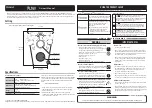
3. Steps Between Notes
This window shows the number of steps between notes on the “From” line and
the “To” line. Dial the Harmonizer until the note you wish to measure to appears
above the note you wish to measure from. For instance, when B appears above
D, 4½ appears in the window indicating the tonal distance between the two
notes. This measurement assumes that the two notes are within the same
octave and the note you’re going to is the higher note. Since twelve half steps
make an octave, the highest number of whole steps is six.
This window shows the interval between the notes on the “From” line and the
“To” line. The “from” line represents the lower of the two notes. The “To” line rep-
resents the higher note. Dial the Harmonizer until the note you wish to calculate
the interval of appears above the note on the “From” line. For instance, when B
appears above D, 6 appears in the window. This indicates that the interval from
D to B is a perfect sixth.
Below is a list of the shorthand symbols to indicate the intervals.
Note: It may seem like a contradiction that the maximum number of steps in an
octave scale is six. However, remember that the scale is made up of eight notes
that span a total of six whole steps. Intervals basically are counting notes, while
steps count the distance between the notes. (See p. 13 for a list of interval
names and step distances.)
Interval Name
<2
Minor Second
2
Major Second
<3
Minor Third
3
Major Third
4
Perfect Fourth
<5
Augmented Fourth (or Diminished Fifth)
5
Perfect Fifth
>5
Augmented Fifth (or Diminished Sixth)
6
Major Sixth
<7
Minor Seventh
7
Major Seventh
O
Octave
Symbol
3.
Steps Between Notes
4.
Interval
38



































